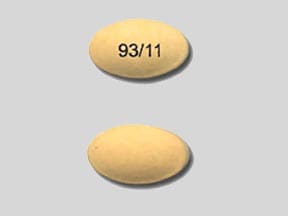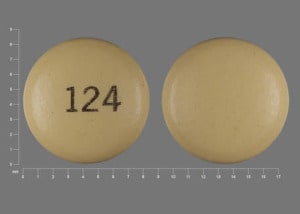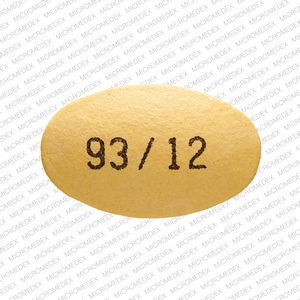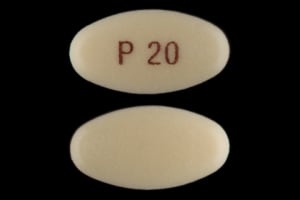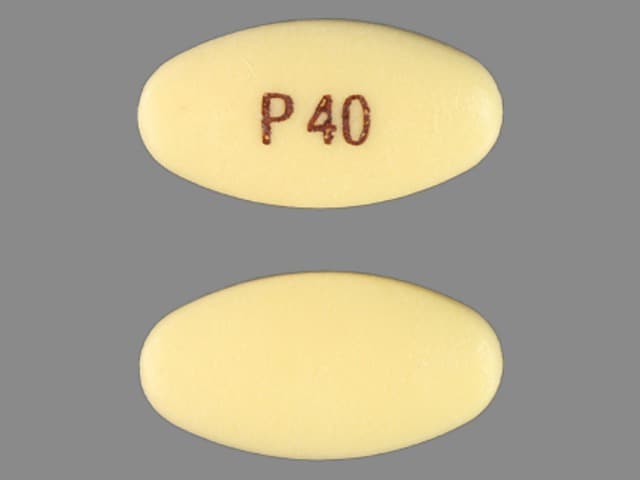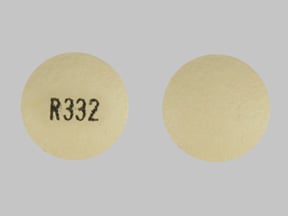Dosage Forms
Excipient information presented when available (limited, particularly for generics); consult specific product labeling.
Packet, Oral:
Protonix: 40 mg (1 ea, 30 ea) [contains polysorbate 80]
Solution Reconstituted, Intravenous:
Generic: 40 mg (1 ea)
Solution Reconstituted, Intravenous [preservative free]:
Protonix: 40 mg (1 ea) [contains edetate disodium]
Generic: 40 mg (1 ea)
Tablet Delayed Release, Oral:
Protonix: 20 mg, 40 mg
Generic: 20 mg, 40 mg
Pharmacology
Mechanism of Action
Proton pump inhibitor, suppresses gastric acid secretion by inhibiting the parietal cell H+/K+ ATP pump
Pharmacokinetics/Pharmacodynamics
Absorption
Rapid, well absorbed
Distribution
Vd:
Children and Adolescents (Kearns 2008): IV (2 to 16 years of age): 0.22 ± 0.14 L/kg; Oral (5 to 16 years of age): 0.24 ± 0.09 L/kg
Adults: 11 to 23.6 L
Metabolism
Extensively hepatic; CYP2C19 (demethylation), CYP3A4; no evidence that metabolites have pharmacologic activity
Excretion
Urine (71% as metabolites); feces (18%); pantoprazole clearance increased with weight and age (Pettersen 2009)
Onset of Action
Onset of action: Acid secretion: Oral: 2.5 hours; IV: 15 to 30 minutes
Maximum effect: IV: 2 hours
Time to Peak
Children and Adolescents (Kearns 2008): IV (2 to 16 years of age): 0.34 ± 0.12 hours; Oral (5 to 16 years of age): 2.54 ± 0.72 hours
Adults: Oral: 2.5 hours
Duration of Action
Oral, IV: 24 hours
Half-Life Elimination
Neonates (PMA: 37 to 44 weeks): ~3 hours (Ward 2010)
Children and Adolescents (Kearns 2008): IV (2 to 16 years of age): 1.22 ± 0.68 hours; Oral (5 to 16 years of age): 1.27 ± 1.29 hours
Adults: 1 hour; increased to 3.5 to 10 hours with CYP2C19 deficiency
Protein Binding
98%, primarily to albumin
Use in Specific Populations
Special Populations: Hepatic Function Impairment
Increase in serum elimination half-life to 7 to 9 hours; AUC increases by 5- to 7-fold.
Special Populations: Elderly
Moderate increase in AUC (43%) and Cmax (26%) after oral administration.
Special Populations: Gender
A modest increase in AUC and Cmax in women.
Use: Labeled Indications
Oral:
Gastroesophageal reflux disease, erosive or nonerosive:
Treatment of erosive esophagitis: Short-term treatment in the healing and symptomatic relief of erosive esophagitis in adults and pediatric patients ≥5 years of age.
Maintenance healing of erosive esophagitis: Maintenance of healing of erosive esophagitis and reduction in relapse rates of daytime and nighttime heartburn symptoms in adult patients.
Zollinger-Ellison syndrome: Long-term treatment of pathological hypersecretory conditions, such as Zollinger-Ellison syndrome.
IV:
Gastroesophageal reflux disease associated with a history of erosive esophagitis: Short-term treatment of adult patients with gastroesophageal reflux disease and a history of erosive esophagitis.
Zollinger-Ellison syndrome: Treatment of adult patients with pathological hypersecretory conditions, such as Zollinger-Ellison syndrome.
Use: Off Label
Aspiration prophylaxis in patients undergoing anesthesiabyes
Data from several studies of varying methodologies (including randomized, single-blind and double-blind, parallel-group trials) and a meta-analysis support the use of pantoprazole for the prevention of aspiration in patients undergoing anesthesia. Studies were conducted in the elective surgery setting Bhattacharyya 2011, Memis 2003, Pisegna 2009, Puig 2012.
Based on the American Society of Anesthesiologists practice guidelines for preoperative fasting and the use of pharmacologic agents to reduce the risk of pulmonary aspiration, proton pump inhibitors (PPIs) (eg, pantoprazole) are an effective and recommended option for use in patients at high risk for aspiration.
Barrett esophaguscyes
Data from an observational study suggest that use of a PPI, such as pantoprazole, may prevent cancer and the progression of dysplasia in patients with this condition Kastelein 2013, although evidence is conflicting Hu 2017. Clinical experience also suggests the utility of PPIs in the treatment of patients with Barrett esophagus and symptomatic gastroesophageal reflux disease (GERD) or endoscopic evidence of reflux esophagitis Spechler 2019.
Based on the American College of Gastroenterology (ACG) clinical guideline for diagnosis and management of Barrett esophagus, PPIs (eg, pantoprazole) are effective and recommended in patients with this condition Shaheen 2016.
Dyspepsia, functional (idiopathic or non-ulcer)ayes
Data from a multicenter, double-blind, placebo-controlled trial as well as from a double-blind noninferiority trial support the use of pantoprazole for the treatment of functional dyspepsia Jung 2016, van Rensburg 2008. In addition, data from a systematic review support the use of pantoprazole for the treatment of patients with ulcer and reflux-like functional dyspepsia Pinto-Sanchez 2017.
Based on the ACG and Canadian Association of Gastroenterology (CAG) guidelines for the management of dyspepsia, the use of pantoprazole is effective and recommended treatment for functional dyspepsia ACG/CAG [Moayyedi 2017].
Helicobacter pylori eradicationyes
Based on the ACG clinical guideline for treatment of H. pylori infection, the use of PPIs, as part of an appropriate combination regimen with antibiotics, is effective and recommended in the treatment of H. pylori infection ACG [Chey 2017].
Nonsteroidal anti-inflammatory drug (including aspirin)–induced ulcers, primary preventionbyes
Data from a randomized, double-blind, multicenter, parallel-group study and from a limited number of patients in a placebo-controlled, double-blind, parallel-group study support the use of pantoprazole in the prevention of nonsteroidal anti-inflammatory drug (NSAID)–induced ulcers Bianchi Porro 2000, Regula 2006.
Based on the ACG 2009 guidelines for prevention of NSAID-related ulcer complications, PPIs (including pantoprazole) are effective and recommended in the prophylaxis of gastric and duodenal ulcers in patients receiving NSAID therapy Lanza 2009. In addition, based on the European Society of Cardiology (ESC) guidelines for the management of acute myocardial infarction in patients presenting with ST-segment elevation and the American College of Cardiology Foundation/ACG/American Heart Association expert consensus document on the concomitant use of PPIs and thienopyridines, PPIs are effective and recommended for gastric protection in patients on dual antiplatelet therapy (eg, aspirin plus a P2Y12 inhibitor) who are at high risk for GI bleeding, such as those with a history of GI ulcer/bleeding or with multiple additional risk factors (eg, H. pylori infection, concurrent use of anticoagulants or corticosteroids) Abraham 2010, Ibanez 2018.
Peptic ulcer disease, maintenance therapy/secondary preventionb
Data from a randomized, double-blind trial and a parallel, randomized, placebo-controlled noninferiority trial support the use of pantoprazole for secondary prevention of ulcers and/or GI bleeding in select high-risk patients with a need for continued aspirin Ng 2010, Sung 2010. Clinical experience also suggests the utility of pantoprazole for maintenance therapy/secondary prevention in select high-risk patients, such as those with idiopathic ulcers, frequently recurrent ulcers, or a need for continued NSAID use Feldman 2019a.
Peptic ulcer disease, treatment of bleeding ulcersayes
Data from multiple randomized clinical trials, including both open-label and double-blind, randomized trials, in patients with active peptic ulcer bleeding treated with either continuous infusion or intermittent IV pantoprazole after endoscopic hemostasis support the use of either continuous infusion or intermittent pantoprazole for the treatment of this condition Hsu 2010, Hung 2007, Yamada 2012, Zargar 2006.
Based on international consensus recommendations on the management of patients with nonvariceal upper GI bleeding and ACG guidelines on management of patients with ulcer bleeding, an IV PPI regimen may be considered prior to endoscopy in select patients with a bleeding ulcer and should be used following successful endoscopy in select patients who had active bleeding or a high-risk stigmata of recent hemorrhage Barkun 2010, Laine 2012.
Peptic ulcer disease, treatment of uncomplicated ulcersa
Data from randomized, double-blind studies support the use of oral pantoprazole for the treatment of uncomplicated peptic ulcers Cremer 1995, Rehner 1995, Witzel 1995.
Stress ulcer prophylaxis in select critically ill patientscyes
Data from randomized, blinded, placebo-controlled, parallel-group trials in critically ill patients with GI bleeding risk factors found no clinically significant differences in those receiving pantoprazole compared to those receiving placebo Alhazzani 2017, Krag 2018, Selvanderan 2016. Further evaluation is warranted, particularly to better define risk factors Barletta 2016.
Based on the Surviving Sepsis Campaign international guidelines for the management of severe sepsis and septic shock, stress ulcer prophylaxis using a PPI is an effective and recommended option in select critically ill patients with GI bleeding risk factors.
Contraindications
Hypersensitivity (eg, anaphylaxis, anaphylactic shock, angioedema, bronchospasm, acute interstitial nephritis, urticaria) to pantoprazole, other substituted benzimidazole proton pump inhibitors, or any component of the formulation; in combination with rilpivirine-containing products.
Canadian labeling: Additional contraindications (not in US labeling): Concomitant use with rilpivirine
Dosage and Administration
Dosing: Adult
Note: Do not administer concomitantly with other antisecretory agents, such as H2-receptor antagonists (H2RAs), prostaglandin analogues (eg, misoprostol), or somatostatin analogues (eg, octreotide), due to decreased acid-inhibitory effects; if another antisecretory agent is needed, allow a sufficient time interval between administration (ie, morning pantoprazole and bedtime H2RA) (ACG [Katz 2013]; Wolfe 2000; Wolfe 2019).
Aspiration prophylaxis in patients undergoing anesthesia (off-label use):
Note: May be considered in patients at high risk for aspiration (ASA 2017).
Oral: 40 mg given the night before surgery and 40 mg given the morning of surgery (Bhattacharyya 2011; Puig 2012).
IV: 40 mg as a single dose 1 hour prior to induction anesthesia (Brown 2019; Memiş 2003; Pisegna 2009; Puig 2012).
Barrett esophagus (off-label use):
Oral: 40 mg once daily; may increase the dose to 40 mg twice daily if needed to eliminate gastroesophageal reflux disease (GERD) symptoms or heal reflux esophagitis. Long-term maintenance therapy is recommended (ACG [Shaheen 2016]; Babic 2015; Spechler 2019).
Dyspepsia, functional (idiopathic or non-ulcer) (off-label use):
Note: For patients who test negative for Helicobacter pylori infection or have persistent symptoms following H. pylori eradication (ACG/CAG [Moayyedi 2017]; Longstreth 2019).
Oral: 20 to 40 mg once daily for a 4- to 8-week trial (Jung 2016; Pinto-Sanchez 2017; van Rensburg 2008); can be continued for a longer duration in patients with symptom improvement. Some experts recommend attempting to discontinue every 6 to 12 months to minimize the long-term risk of therapy (Longstreth 2019).
Gastroesophageal reflux disease, erosive or nonerosive:
Initial therapy:
Mild/intermittent disease (<2 episodes/week) and no evidence of erosive esophagitis:
Note: Some experts reserve proton pump inhibitors (PPIs) for patients who have residual acid reflux symptoms despite twice-daily H2RA (Kahrilas 2019).
Oral: 20 mg once daily, can increase to 40 mg once daily after 4 to 8 weeks if necessary. Discontinue once asymptomatic for 8 weeks (Kahrilas 2019).
Severe and/or frequent symptoms (≥2 episodes/week), and/or erosive esophagitis:
Oral: 40 mg once daily; once symptoms are controlled, continue for at least 8 weeks (Kahrilas 2019; Province of British Columbia Ministry of Health 2015; Wolfe 2000). Subsequently, patients without severe erosive esophagitis or Barrett esophagus can taper to the lowest dose necessary to control symptoms (and/or switch to an H2RA blocker), then discontinue acid suppression once asymptomatic. Patients with severe erosive esophagitis or Barrett esophagus should continue long-term maintenance therapy with 40 mg once daily (Kahrilas 2019; Ramakrishnan 2002; Spechler 2019).
IV (in patients unable to receive oral medications): 40 mg once daily, then switch to oral when possible (Metz 2000).
Residual symptoms despite 40 mg once daily therapy:
Note: Referral to a specialist is recommended.
Oral: Options include splitting the dose to 20 mg twice daily, increasing the dose to 40 mg twice daily, or switching to another PPI (ACG [Katz 2013]; Fass 2019; Wang 2009).
Helicobacter pylori eradication (off-label use):
Oral: 40 mg or 80 mg twice daily as part of an appropriate combination regimen with antibiotics. Dose depends on the selected regimen (ACG [Chey 2017]; Crowe 2019; Fallone 2016).
Nonsteroidal anti-inflammatory drugs (including aspirin)–induced ulcers, primary prevention (off-label use):
Note: For select patients at moderate or high risk for GI toxicity. These include patients with a history of GI ulcer, on dual antiplatelet therapy (eg, aspirin plus a P2Y12 inhibitor), on concurrent anticoagulant therapy, or with multiple additional risk factors (eg, corticosteroid use, high nonsteroidal anti-inflammatory drug [NSAID] dose, H. pylori infection) (Feldman 2019b; Holmes 2019). For patients on dual antiplatelet therapy, some experts reserve prophylaxis for those with additional risk factors (ACCF/ACG/AHA [Abraham 2010]; ESC [Ibanez 2018]). If present, H. pylori infection should be treated first (ACG [Lanza 2009]; Feldman 2019b).
Oral: 20 to 40 mg once daily for the duration of high-risk NSAID use (Bianchi Porro 2000; Cuisset 2009; Regula 2006; Sibbing 2009).
Peptic ulcer disease, treatment and secondary prevention (off-label use):
Note: For patients on NSAIDs (including aspirin), the NSAID should be discontinued, if possible (Feldman 2019a). If present, H. pylori infection should be treated first; H. pylori–associated ulcers may not need PPI treatment beyond that included in the eradication regimen (Vakil 2019a).
Uncomplicated ulcer: Oral: 40 mg once daily for 4 weeks for duodenal ulcers and 8 weeks for gastric ulcers (Cremer 1995; Rehner 1995; Savarino 1998; Witzel 1995). In patients with refractory or recurrent disease, may increase the dose to 40 mg twice daily (Vakil 2019a; Vakil 2019b).
Bleeding ulcer: Note: For clinically significant upper GI bleeding prior to endoscopy (Saltzman 2019).
Initial therapy: Note: The optimal IV dosing regimen has not been established; clinical practice guidelines recommend a continuous infusion (Barkun 2010), whereas other experts prefer an intermittent dosing regimen as a noninferior option that may offer potential cost savings (Hsu 2010; Hung 2007; Sachar 2014; Saltzman 2019; Yamada 2012; Yüksel 2008).
IV: Intermittent dosing: Loading dose of 80 mg, followed by 40 mg every 12 hours (Hsu 2010; Hung 2007; Yamada 2012, Saltzman 2019).
IV: Continuous infusion: Loading dose of 80 mg, followed by 8 mg/hour infusion (Barkun 2010; Sung 2010; van Rensburg 2009; Zargar 2006).
Oral(reserve for situations when IV PPI is unavailable): 40 mg twice daily (Saltzman 2019).
Post-endoscopy therapy: Note: For patients who had active bleeding or high-risk stigmata of recent hemorrhage, IV PPI therapy can be transitioned to oral therapy 72 hours after endoscopy, provided there is no evidence of recurrent bleeding (Saltzman 2019).
Oral: 40 mg once daily. The duration of treatment depends on the location and cause of the ulcer (Saltzman 2019).
Maintenance therapy/secondary prevention: Note: For select high-risk patients (eg, idiopathic ulcers, frequently recurrent ulcers, need for continued NSAID use).
Oral: 20 to 40 mg once daily (Feldman 2019a; Ng 2010; Sung 2010).
Stress ulcer prophylaxis in select critically ill patients (off-label use):
Note: For ICU patients with associated risk factors for GI bleeding (including coagulopathy, mechanical ventilation for >48 hours, traumatic brain injury, history of GI ulceration or bleeding within past year, extensive burns) (Rhodes 2017; Weinhouse 2019).
IV: 40 mg once daily (Alhazzani 2017; Krag 2018; Selvanderan 2016).
Oral or via nasogastric tube: 40 mg once daily (Spirt 2006; Wensel 2009).
Duration: Discontinue prophylaxis once critical illness and modifiable risk factors have resolved (Rhodes 2017; Weinhouse 2019).
Zollinger-Ellison syndrome:
Oral: Initial: 80 mg twice daily; if needed, may titrate upward early in therapy to a maximum of 240 mg/day (as either 80 mg three times daily or 120 mg twice daily); once acid output has been controlled, gradual dose reductions are usually possible; reported maintenance dosage range: 40 to 200 mg/day (mean: 116 mg/day); daily doses ≥80 mg are usually given in 2 to 3 divided doses; continue therapy as long as clinically indicated (Bergsland 2019; Metz 2006; Ramdani 2002).
IV (when oral administration is not possible): Initial: 80 mg every 8 to 12 hours; doses up to 240 mg/day (given as 120 mg every 12 hours or 80 mg every 8 hours) have been used for a limited period of time (up to 6 days); switch to oral administration when possible (Lew 2000; Metz 2001).
Discontinuation of therapy: In patients who have received continuous therapy for >6 months, some experts gradually taper therapy until discontinuation to avoid worsening or rebound symptoms. There is no single agreed upon discontinuation strategy. If the patient is receiving 40 mg once or twice daily, some experts decrease the dose by 50% every week. For patients receiving twice-daily dosing, the first dose reduction can be achieved by decreasing to once-daily AM dosing. Once patients are on the lowest dose for 1 week, discontinue therapy (Wolfe 2019). An alternative strategy is to decrease the dose by 50% over 2 to 4 weeks, then discontinue. If the patient is already on the lowest possible dose, alternate-day therapy may be considered (Kim 2018). In addition, as-needed therapy with an H2RA or an antacid can be used during the taper (Haastrup 2014).
Dosing: Geriatric
Refer to adult dosing.
Dosing: Pediatric
Note: Parenteral therapy should be discontinued as soon as the patient tolerates oral therapy.
GERD, symptomatic: Limited data available:
Infants and Children <5 years: Oral: 1.2 mg/kg/day once daily for 4 weeks was shown to reduce GERD symptoms but was not significantly different from placebo (n=128; age range: 1 to 11 months) (Winter 2010); a pharmacokinetic trial showed this dose produced similar serum concentrations as adults receiving 40 mg in infants 1 to 11 months (mean age: 6.3 months) and slightly lower concentrations in children 1 to <6 years (mean age: 3.2 years) (Tammara 2011)
Children 5 to 11 years: Oral: 20 or 40 mg once daily have been shown to reduce severity and frequency of symptoms within 1 week based on the GERD Assessment of Symptoms in Pediatric Patients Questionnaire (n=53, age range: 5 to 11 years); results also showed that while a lower dose of 10 mg improved symptoms, it took longer (3 weeks) for results (Tolia 2006); a pharmacokinetic trial in patients 6 to 11 years old (n=24) showed that 40 mg once daily produced similar systemic exposure as adults receiving 40 mg; however, the authors suggested that 20 mg once daily may be appropriate for small children (Ward 2011)
Children and Adolescents 12 to 16 years: Oral: 20 or 40 mg once daily was shown to reduce symptoms in patients with confirmed or clinically suspected diagnosis of GERD (n=136) based on the GERD Assessment of Symptoms in Pediatric Patients Questionnaire (Tsou 2011); a pharmacokinetic trial showed that a 40 mg dose produced similar systemic exposure as adults receiving 40 mg; however, suggested that 20 mg once daily may be appropriate for smaller adolescents (<40 kg) (Ward 2011)
Erosive esophagitis associated with GERD:
Children 1 to 5 years: Limited data available: Oral: 0.3, 0.6, or 1.2 mg/kg/day once daily for 8 weeks was used in a dose-finding study of 60 patients with histologic or erosive esophagitis. High-dose treatment (1.2 mg/kg/day) was administered as a fixed dose of either: 15 mg for 1-year-olds or 20 mg for 2- to 5-year-olds. Patients with erosive esophagitis (n=4) received either 0.6 or 1.2 mg/kg/day. All patients had symptomatic improvement and patients with erosive esophagitis were healed by week 8; no dose response relationship was demonstrated (Baker 2010)
Children ≥5 years and Adolescents: Oral:
≥15 to <40 kg: 20 mg once daily for up to 8 weeks
≥40 kg: 40 mg once daily for up to 8 weeks
Gastric acid suppression; oral therapy not appropriate or tolerated: Limited data available; dosing regimens variable: Infants, Children, and Adolescents: IV: Dosing based on pharmacokinetic data from 39 pediatric patients (age range: 10 days to 16 years) which has shown doses within this range produce similar AUC as adult patients with comparable dosing; efficacy was not evaluated in either trial (Kearns 2008; Petersen 2009).
Weight-based dosing: Children ≥2 years and Adolescents: IV: 0.8 or 1.6 mg/kg once daily; maximum single dose: 80 mg; dosing from a single dose pharmacokinetic study in 18 patients (age range: 2 to 14 years) (Kearns 2008). In the BSA-based dosing trial (Petersen 2009), the final median dose when standardized to weight was 1.1 mg/kg/day (range: 0.5 to 4.6 mg/kg/day). (Note: The 4.6 mg/kg/day dose was a prescription error; however, the patient experienced no adverse consequences due to high dose). Additionally, some clinicians have used 1 to 2 mg/kg/day in single or divided doses. Note: In a very small trial (n=8), a median dose of 1.1 mg/kg (0.9 to 2.5 mg/kg) produced similar AUC values as adults, but only produced a definable response (gastric pH >4) in one patient; in the remaining seven patients the mean percentage of time with intragastric pH ≥4 was 7.4 % (Petersen 2005); the pharmacodynamic profile needs further defined (Petersen 2009)
Body surface area (BSA)-based dosing: Infants, Children, and Adolescents: IV: 40 mg/1.73 m2/day; if inadequate response (eg, continued symptoms or target gastric pH not achieved) may titrate up to a maximum dose of 80 mg/1.73 m2/day; dosing based on multidose pharmacokinetic analysis; in the final analysis, the median reported dose was 41.8 mg/1.73 m2/day (range: 19.9-140.6 mg/1.73 m2/day) (Note: The 140.6 mg/1.73 m2/day dose was a prescription error; however, the patient experienced no adverse consequences due to high dose) (Petersen 2009).
Reconstitution
15-minute infusion:
40 mg dose: Reconstitute 1 vial with 10 mL of NS; further dilute with 100 mL of D5W, NS, or LR to a final concentration of ~0.4 mg/mL.
80 mg dose: Reconstitute 2 vials each with 10 mL of NS; combine the content of both vials and further dilute with 80 mL of D5W, NS, or LR to a final concentration of ~0.8 mg/mL.
2-minute infusion: Reconstitute with 10 mL of NS to a final concentration of ~4 mg/mL.
Extemporaneously Prepared
A 2 mg/mL pantoprazole oral suspension may be made with pantoprazole tablets, sterile water, and sodium bicarbonate powder. Remove the Protonix® imprint from twenty 40 mg tablets with a paper towel dampened with ethanol (improves the look of product). Let tablets air dry. Crush the tablets in a mortar and reduce to a fine powder. Transfer to a 600 mL beaker, and add 340 mL sterile water. Place beaker on a magnetic stirrer. Add 16.8 g of sodium bicarbonate powder and stir for about 20 minutes until the tablet remnants have disintegrated. While stirring, add another 16.8 g of sodium bicarbonate powder and stir for about 5 minutes until powder has dissolved. Add enough sterile water for irrigation to bring the final volume to 400 mL. Mix well. Transfer to amber-colored bottle. Label "shake well" and "refrigerate". Stable for 62 days refrigerated.
Dentinger PJ, Swenson CF, and Anaizi NH, “Stability of Pantoprazole in an Extemporaneously Compounded Oral Liquid,” Am J Health Syst Pharm, 2002, 59(10):953-6.12040734
Administration
IV: Flush IV line before and after administration with D5W, NS, or LR. In-line filter not required.
2-minute infusion: The volume of reconstituted solution (4 mg/mL) may be administered intravenously over at least 2 minutes.
15-minute infusion: Infuse over ~15 minutes at a rate of ~7 mL/minute (3 mg/minute).
Continuous infusion: May also be administered as a continuous infusion for the prevention of rebleeding with in peptic ulcer bleed (off-label use).
Oral:
Tablet: Should be swallowed whole, do not split, crush, or chew. For most indications, administer 30 to 60 minutes before a meal (preferably); best if taken before breakfast (ACG [Katz 2013]). If administering twice daily, first dose should be administered before breakfast and the second dose before dinner (ACG [Katz 2013]; Hershcovici 2010). Manufacturer’s labeling states that tablets may be administered with or without food and concomitant administration of antacids do not affect absorption.
Delayed-release oral suspension: Should only be administered in apple juice or applesauce and taken ~30 minutes before a meal; do not chew or crush granules. Do not administer with any other liquid (eg, water) or foods.
Oral administration in applesauce: Sprinkle intact granules on 1 teaspoon of applesauce and swallow within 10 minutes of preparation.
Oral administration in apple juice: Empty intact granules into 5 mL of apple juice, stir for 5 seconds (granules will not dissolve), and swallow immediately after preparation. Rinse container once or twice with apple juice and swallow immediately.
Nasogastric tube administration: Separate the plunger from the barrel of a 60 mL catheter tip syringe and connect to a ≥16 French nasogastric tube. Holding the syringe attached to the tubing as high as possible, empty the contents of the packet into barrel of the syringe, add 10 mL of apple juice and gently tap/shake the barrel of the syringe to help empty the syringe. Add an additional 10 mL of apple juice and gently tap/shake the barrel to help rinse. Repeat rinse at least twice with 10 mL aliquots of apple juice. No granules should remain in the syringe.
Dietary Considerations
IV: Due to EDTA in preparation, zinc supplementation may be needed in patients prone to zinc deficiency.
Storage
Oral: Store tablet and oral suspension at 20°C to 25°C (68°F to 77°F); excursions permitted to 15°C to 30°C (59°F to 86°F).
IV: Prior to reconstitution, store at 20°C to 25°C (68°F to 77°F); excursions permitted to 15°C to 30°C (59°F to 86°F). Do not freeze. Protect from light prior to reconstitution; upon reconstitution, protection from light is not required. Do not freeze reconstituted solution. Per manufacturer's labeling, reconstituted solution is stable at room temperature for up to 6 hours; further diluted (admixed) solution in D5W, LR, or NS should be stored at room temperature and used within 24 hours from the time of initial reconstitution. However, studies have shown that reconstituted solution (4 mg/mL) in polypropylene syringes is stable up to 96 hours at room temperature (Johnson 2005). Upon further dilution, the admixed solution should be used within 96 hours from the time of initial reconstitution. The preparation should be stored at 3°C to 5°C (37°F to 41°F) if it is stored beyond 48 hours to minimize discoloration.
Pantoprazole Images
Drug Interactions
Acalabrutinib: Proton Pump Inhibitors may decrease the serum concentration of Acalabrutinib. Avoid combination
Amphetamine: Proton Pump Inhibitors may increase the absorption of Amphetamine. Monitor therapy
Atazanavir: Proton Pump Inhibitors may decrease the serum concentration of Atazanavir. Management: See full drug interaction monograph for details. Consider therapy modification
Bisphosphonate Derivatives: Proton Pump Inhibitors may diminish the therapeutic effect of Bisphosphonate Derivatives. Monitor therapy
Bosutinib: Proton Pump Inhibitors may decrease the serum concentration of Bosutinib. Management: Consider alternatives to proton pump inhibitors, such as short-acting antacids or histamine-2 receptor antagonists. Administer alternative agents more than 2 hours before or after bosutinib. Consider therapy modification
Capecitabine: Proton Pump Inhibitors may diminish the therapeutic effect of Capecitabine. Monitor therapy
Cefditoren: Proton Pump Inhibitors may decrease the serum concentration of Cefditoren. Management: If possible, avoid use of cefditoren with proton pump inhibitors (PPIs). Consider alternative methods to minimize/control acid reflux (eg, diet modification) or alternative antimicrobial therapy if use of PPIs can not be avoided. Consider therapy modification
Cefpodoxime: Proton Pump Inhibitors may decrease the serum concentration of Cefpodoxime. Monitor therapy
Cefuroxime: Proton Pump Inhibitors may decrease the absorption of Cefuroxime. Avoid combination
Clopidogrel: Pantoprazole may decrease serum concentrations of the active metabolite(s) of Clopidogrel. Management: Due to the possible risk for impaired clopidogrel effectiveness, clinicians should carefully consider the need for proton pump inhibitor therapy in patients receiving clopidogrel. Other acid-lowering therapies do not appear to share this interaction. Monitor therapy
CYP2C19 Inducers (Moderate): May decrease the serum concentration of CYP2C19 Substrates (High risk with Inducers). Monitor therapy
CYP2C19 Inducers (Strong): May increase the metabolism of CYP2C19 Substrates (High risk with Inducers). Management: Consider an alternative for one of the interacting drugs. Some combinations may be specifically contraindicated. Consult appropriate manufacturer labeling. Consider therapy modification
Cysteamine (Systemic): Proton Pump Inhibitors may diminish the therapeutic effect of Cysteamine (Systemic). Monitor therapy
Dabrafenib: May decrease the serum concentration of CYP2C19 Substrates (High risk with Inducers). Management: Seek alternatives to the CYP2C19 substrate when possible. If concomitant therapy cannot be avoided, monitor clinical effects of the substrate closely (particularly therapeutic effects). Consider therapy modification
Dacomitinib: Proton Pump Inhibitors may decrease the serum concentration of Dacomitinib. Management: Avoid concurrent use of dacomitinib with proton pump inhibitors. Antacids may be used. Histamine H2-receptor antagonists (HR2A) may be used if dacomitinib is given at least 6 hours before or 10 hours after the H2RA. Avoid combination
Dasatinib: Proton Pump Inhibitors may decrease the serum concentration of Dasatinib. Management: Antacids (taken 2 hours before or after dasatinib administration) can be used in place of the proton pump inhibitor if some acid-reducing therapy is needed. Avoid combination
Delavirdine: Proton Pump Inhibitors may decrease the serum concentration of Delavirdine. Management: Chronic therapy with proton pump inhibitors (PPIs) should be avoided in patients treated with delavirdine. The clinical significance of short-term PPI therapy with delavirdine is uncertain, but such therapy should be undertaken with caution. Avoid combination
Dexmethylphenidate: Proton Pump Inhibitors may increase the absorption of Dexmethylphenidate. Specifically, proton pump inhibitors may interfere with the normal release of drug from the extended-release capsules (Focalin XR brand), which could result in both increased absorption (early) and decreased delayed absorption. Monitor therapy
Dextroamphetamine: Proton Pump Inhibitors may increase the absorption of Dextroamphetamine. Specifically, the dextroamphetamine absorption rate from mixed amphetamine salt extended release (XR) capsules may be increased in the first hours after dosing. Monitor therapy
Doxycycline: Proton Pump Inhibitors may decrease the bioavailability of Doxycycline. Monitor therapy
Enzalutamide: May decrease the serum concentration of CYP2C19 Substrates (High risk with Inducers). Conversely, concentrations of active metabolites may be increased for those drugs activated by CYP2C19. Management: Concurrent use of enzalutamide with CYP2C19 substrates that have a narrow therapeutic index should be avoided. Use of enzalutamide and any other CYP2C19 substrate should be performed with caution and close monitoring. Consider therapy modification
Erlotinib: Proton Pump Inhibitors may decrease the serum concentration of Erlotinib. Avoid combination
Fluconazole: May increase the serum concentration of Proton Pump Inhibitors. Monitor therapy
Gefitinib: Proton Pump Inhibitors may decrease the serum concentration of Gefitinib. Management: Avoid use of proton pump inhibitors (PPIs) with gefitinib when possible. If required, administer gefitinib 12 hours after administration of the PPI or 12 hours before the next dose of the PPI. Consider therapy modification
Indinavir: Proton Pump Inhibitors may decrease the serum concentration of Indinavir. Monitor therapy
Iron Preparations: Proton Pump Inhibitors may decrease the absorption of Iron Preparations. Exceptions: Ferric Carboxymaltose; Ferric Citrate; Ferric Derisomaltose; Ferric Gluconate; Ferric Hydroxide Polymaltose Complex; Ferric Pyrophosphate Citrate; Ferumoxytol; Iron Dextran Complex; Iron Sucrose. Monitor therapy
Itraconazole: Proton Pump Inhibitors may increase the serum concentration of Itraconazole. Proton Pump Inhibitors may decrease the serum concentration of Itraconazole. Management: Exposure to Tolsura brand itraconazole may be increased by PPIs; consider itraconazole dose reduction. Exposure to Sporanox brand itraconazole capsules may be decreased by PPIs. Give Sporanox brand itraconazole at least 2 hrs before or 2 hrs after PPIs Consider therapy modification
Ketoconazole (Systemic): Proton Pump Inhibitors may decrease the absorption of Ketoconazole (Systemic). Ketoconazole (Systemic) may increase the serum concentration of Proton Pump Inhibitors. Management: Administer ketoconazole with an acidic beverage, such as non-diet cola, to increase gastric acidity and improve absorption if concomitant use with proton pump inhibitors is necessary. Consider therapy modification
Ledipasvir: Proton Pump Inhibitors may decrease the serum concentration of Ledipasvir. Management: PPI doses equivalent to omeprazole 20 mg or lower may be given with ledipasvir under fasted conditions. Administration with higher doses of PPIs, 2 hours after a PPI, or in combination with food and PPIs may reduce ledipasvir bioavailability. Consider therapy modification
Lumacaftor and Ivacaftor: May decrease the serum concentration of CYP2C19 Substrates (High risk with Inducers). Monitor therapy
Lumacaftor and Ivacaftor: May decrease the serum concentration of Proton Pump Inhibitors. Monitor therapy
Mesalamine: Proton Pump Inhibitors may diminish the therapeutic effect of Mesalamine. Proton pump inhibitor-mediated increases in gastrointestinal pH may cause the premature release of mesalamine from specific sustained-release mesalamine products. Management: Consider avoiding concurrent administration of high-dose proton pump inhibitors (PPIs) with sustained-release mesalamine products. Consider therapy modification
Methotrexate: Proton Pump Inhibitors may increase the serum concentration of Methotrexate. Monitor therapy
Methylphenidate: Proton Pump Inhibitors may increase the absorption of Methylphenidate. Specifically, proton pump inhibitors may interfere with the normal release of drug from the extended-release capsules (Ritalin LA brand), which could result in both increased absorption (early) and decreased delayed absorption. Monitor therapy
Multivitamins/Minerals (with ADEK, Folate, Iron): Proton Pump Inhibitors may decrease the serum concentration of Multivitamins/Minerals (with ADEK, Folate, Iron). Specifically, the absorption of iron may be decreased. Monitor therapy
Mycophenolate: Proton Pump Inhibitors may decrease the serum concentration of Mycophenolate. Specifically, concentrations of the active mycophenolic acid may be reduced. Monitor therapy
Nelfinavir: Proton Pump Inhibitors may decrease serum concentrations of the active metabolite(s) of Nelfinavir. Proton Pump Inhibitors may decrease the serum concentration of Nelfinavir. Avoid combination
Neratinib: Proton Pump Inhibitors may decrease the serum concentration of Neratinib. Specifically, proton pump inhibitors may reduce neratinib absorption. Avoid combination
Nilotinib: Proton Pump Inhibitors may decrease the serum concentration of Nilotinib. Management: Avoid this combination when possible since separation of doses is not likely to be an adequate method of minimizing the interaction. Consider therapy modification
PAZOPanib: Proton Pump Inhibitors may decrease the serum concentration of PAZOPanib. Avoid combination
Pexidartinib: Proton Pump Inhibitors may decrease the serum concentration of Pexidartinib. Management: If acid-reduction is needed, consider administering an antacid 2 hours before or after pexidartinib, or administer pexidartinib 2 hours before or 10 hours after an H2 receptor antagonist. Avoid combination
Posaconazole: Proton Pump Inhibitors may decrease the serum concentration of Posaconazole. Consider therapy modification
Raltegravir: Proton Pump Inhibitors may increase the serum concentration of Raltegravir. Monitor therapy
Rilpivirine: Proton Pump Inhibitors may decrease the serum concentration of Rilpivirine. Avoid combination
Riociguat: Proton Pump Inhibitors may decrease the serum concentration of Riociguat. Monitor therapy
Risedronate: Proton Pump Inhibitors may diminish the therapeutic effect of Risedronate. Proton Pump Inhibitors may increase the serum concentration of Risedronate. This applies specifically to use of delayed-release risedronate. Consider therapy modification
Saquinavir: Proton Pump Inhibitors may increase the serum concentration of Saquinavir. Monitor therapy
Secretin: Proton Pump Inhibitors may diminish the diagnostic effect of Secretin. Specifically, use of PPIs may cause a hyperresponse in gastrin secretion in response to secretin stimulation testing, falsely suggesting gastrinoma. Management: Avoid concomitant use of proton pump inhibitors (PPIs) and secretin, and discontinue PPIs several weeks prior to secretin administration, with the duration of separation determined by the specific PPI. See full monograph for details. Consider therapy modification
SORAfenib: Proton Pump Inhibitors may decrease the absorption of SORAfenib. Monitor therapy
Tipranavir: May decrease the serum concentration of Proton Pump Inhibitors. These data are derived from studies with Ritonavir-boosted Tipranavir. Monitor therapy
Velpatasvir: Proton Pump Inhibitors may decrease the serum concentration of Velpatasvir. Avoid combination
Voriconazole: May increase the serum concentration of Proton Pump Inhibitors. Proton Pump Inhibitors may increase the serum concentration of Voriconazole. Monitor therapy
Test Interactions
Chromogranin A (CgA) levels: Proton pump inhibitors (PPIs), including pantoprazole, may increase CgA levels, which may interfere with neuroendocrine tumor detection. To avoid interference, stop PPI therapy 14 days prior to CgA measurements.
Tetrahydrocannabinol (THC) urine screening tests: PPIs, including pantoprazole, may cause false-positive urine THC tests. Alternative confirmatory methods should be considered to verify positive results.
Adverse Reactions
Incidences are associated with adults unless otherwise specified.
>10%: Central nervous system: Headache (adults 12%; children & adolescents: >4%)
1% to 10%:
Cardiovascular: Facial edema (children, adolescents, & adults: ≤4%), edema (≤2%), thrombophlebitis (IV: ≤2%)
Central nervous system: Dizziness (children, adolescents, & adults: ≤4%), vertigo (children, adolescents, & adults: ≤4%), depression (≤2%)
Dermatologic: Skin rash (adults: ≤2%; children & adolescents: >4%), urticaria (children, adolescents, & adults: ≤4%), pruritus (≤2%), skin photosensitivity (≤2%)
Endocrine & metabolic: Increased serum triglycerides (children, adolescents, & adults: ≤4%)
Gastrointestinal: Diarrhea (children, adolescents, & adults: 4% to 9%), abdominal pain (children & adolescents: >4%), vomiting (children, adolescents, & adults: ≥4%), constipation (children, adolescents, & adults: ≤4%), flatulence (children & adolescents: ≤4%), nausea (children & adolescents: ≤4%), xerostomia (≤2%)
Hematologic & oncologic: Leukopenia (≤2%), thrombocytopenia (≤2%)
Hepatic: Increased liver enzymes (children, adolescents, & adults: ≤4%), hepatitis (≤2%)
Hypersensitivity: Hypersensitivity reaction (children, adolescents, & adults: ≤4%)
Neuromuscular & skeletal: Arthralgia (children, adolescents, & adults: ≤4%), increased creatine phosphokinase (children, adolescents, & adults: ≤4%), myalgia (children, adolescents, & adults: ≤4%)
Ophthalmic: Blurred vision (≤2%)
Respiratory: Upper respiratory tract infection (children & adolescents: >4%)
Miscellaneous: Fever (adults: ≤2%; children & adolescents: >4%)
<1%, postmarketing, and/or case reports: Acute interstitial nephritis, ageusia, agranulocytosis, anaphylactic shock, anaphylaxis, angioedema, asthenia, bone fracture, Clostridioides (formerly Clostridium) difficile-associated diarrhea, confusion, cutaneous lupus erythematous, drowsiness, dysgeusia, erythema multiforme, fatigue, gastric polyp (fundic gland), hallucination, hepatic failure, hepatotoxicity, hypomagnesemia, hyponatremia, insomnia, jaundice, laboratory test abnormality (false-positive for THC), malaise, pancytopenia, pneumonia (Eom 2011), renal disease (chronic; Lazarus 2016), rhabdomyolysis, severe dermatological reaction, Stevens-Johnson syndrome, systemic lupus erythematosus, toxic epidermal necrolysis, weight changes
Warnings/Precautions
Concerns related to adverse effects:
- Carcinoma: Benign and malignant neoplasia has been observed in long-term (2-year) rodent studies; while not reported in humans, the relevance of these findings in regards to tumorigenicity in humans is not known.
- Clostridioides (formerly Clostridium) difficile-associated diarrhea (CDAD): Use of proton pump inhibitors (PPIs) may increase risk of CDAD, especially in hospitalized patients; consider CDAD diagnosis in patients with persistent diarrhea that does not improve. Use the lowest dose and shortest duration of PPI therapy appropriate for the condition being treated.
- Cutaneous and systemic lupus erythematosus: Has been reported as new onset or exacerbation of existing autoimmune disease; most cases were cutaneous lupus erythematosus (CLE), most commonly, subacute CLE (occurring within weeks to years after continuous therapy). Systemic lupus erythematosus (SLE) is less common (typically occurs within days to years after initiating treatment) and occurred primarily in young adults up to elderly patients. Discontinue therapy if signs or symptoms of CLE or SLE occur and refer to specialist for evaluation; most patients improve 4 to 12 weeks after discontinuation of pantoprazole.
- Fractures: Increased incidence of osteoporosis-related bone fractures of the hip, spine, or wrist may occur with PPI therapy. Patients on high-dose or long-term therapy (≥1 year) should be monitored. Use the lowest effective dose for the shortest duration of time, use vitamin D and calcium supplementation, and follow appropriate guidelines to reduce risk of fractures in patients at risk.
- Fundic gland polyps: Use of PPIs increases risk of fundic gland polyps, especially with long-term use >1 year. May occur without symptoms, but nausea, vomiting, or abdominal pain may occur; GI bleeding and/or anemia may occur with ulcerated polyps. Diagnosis of polyps may also increase risk for small intestinal blockage. Use the lowest dose and shortest duration of PPI therapy appropriate for the condition being treated.
- GI infection (eg, Salmonella, Campylobacter): Use of PPIs may increase risk of these infections.
- Hepatic effects: Mild, transient transaminase elevations have been observed.
- Hypomagnesemia: Reported rarely, usually with prolonged PPI use of ≥3 months (most cases >1 year of therapy). May be symptomatic or asymptomatic; severe cases may cause tetany, seizures, and cardiac arrhythmias. Consider obtaining serum magnesium concentrations prior to beginning long-term therapy, especially if taking concomitant digoxin, diuretics, or other drugs known to cause hypomagnesemia; and periodically thereafter. Hypomagnesemia may be corrected by magnesium supplementation, although discontinuation of pantoprazole may be necessary; magnesium levels typically return to normal within 2 weeks of stopping.
- Infusion-related reactions: Thrombophlebitis and serious hypersensitivity reactions, including anaphylaxis, erythema multiforme, Stevens-Johnson syndrome, and toxic epidermal necrolysis, have been reported with IV administration.
- Interstitial nephritis: Acute interstitial nephritis has been observed in patients taking PPIs; may occur at any time during therapy and is generally due to an idiopathic hypersensitivity reaction. Discontinue if acute interstitial nephritis develops.
- Vitamin B12 deficiency: Prolonged treatment (≥2 years) may lead to vitamin B12 malabsorption and subsequent vitamin B12 deficiency. The magnitude of the deficiency is dose-related and the association is stronger in females and those younger in age (<30 years of age); prevalence is decreased after discontinuation of therapy (Lam 2013).
Disease-related concerns:
- Gastric malignancy: Relief of symptoms does not preclude the presence of a gastric malignancy.
Concurrent drug therapy issues:
- Clopidogrel: PPIs may diminish the therapeutic effect of clopidogrel, thought to be due to reduced formation of the active metabolite of clopidogrel. The manufacturer of clopidogrel recommends either avoidance of both omeprazole (even when scheduled 12 hours apart) and esomeprazole or use of a PPI with comparatively less effect on the active metabolite of clopidogrel. Of the PPIs, pantoprazole has the lowest degree of CYP2C19 inhibition in vitro (Li 2004) and has been shown to have less effect on conversion of clopidogrel to its active metabolite compared to omeprazole (Angiolillo 2011). In contrast to these warnings, others have recommended the continued use of PPIs, regardless of the degree of inhibition, in patients with a history of GI bleeding or multiple risk factors for GI bleeding who are also receiving clopidogrel since no evidence has established clinically meaningful differences in outcome; however, a clinically significant interaction cannot be excluded in those who are poor metabolizers of clopidogrel (Abraham 2010; Levine 2011).
- Drug-drug interactions: Potentially significant interactions may exist, requiring dose or frequency adjustment, additional monitoring, and/or selection of alternative therapy. Consult drug interactions database for more detailed information.
Dosage form specific issues:
- Edetate sodium (EDTA): Some dosage forms may contain edetate sodium; use caution in patients who are at risk for zinc deficiency if other EDTA-containing solutions are coadministered.
- Polysorbate 80: Some dosage forms may contain polysorbate 80 (also known as Tweens). Hypersensitivity reactions, usually a delayed reaction, have been reported following exposure to pharmaceutical products containing polysorbate 80 in certain individuals (Isaksson 2002; Lucente 2000; Shelley 1995). Thrombocytopenia, ascites, pulmonary deterioration, and renal and hepatic failure have been reported in premature neonates after receiving parenteral products containing polysorbate 80 (Alade 1986; CDC 1984). See manufacturer's labeling.
Other warnings/precautions:
- Appropriate use: Helicobacter pylori eradication: Short-term combination therapy (≤7 days) has been associated with a higher incidence of treatment failure. The American College of Gastroenterology recommends 10 to 14 days of therapy (triple or quadruple) for eradication of H. pylori (Chey 2017).
- Laboratory test interference: Serum chromogranin A (CgA) levels increase secondary to drug-induced decreases in gastric acid; may cause false-positive results in diagnostic investigations for neuroendocrine tumors. Temporarily stop pantoprazole treatment at least 14 days before CgA test; if CgA level is high, repeat test to confirm. Use same commercial laboratory for testing to prevent variable results.
Monitoring Parameters
Bone loss and fractures, CDAD, magnesium (baseline and periodically thereafter), and serum gastrin levels
Hypersecretory disorders: Acid output measurements, target level <10 mEq/hour (<5 mEq/hour if prior gastric acid-reducing surgery)
Pregnancy
Pregnancy Considerations
Recommendations for the treatment of gastroesophageal reflux disease in pregnancy are available. As in nonpregnant patients, lifestyle modifications followed by other medications are the initial treatments (Body 2016; Huerta-Iga 2016; Katz 2013; van der Woude 2014). Based on available data, PPIs may be used when clinically indicated (Body 2016; Matok 2012; Pasternak 2010; van der Woude 2014).
Patient Education
What is this drug used for?
- It is used to treat gastroesophageal reflux disease (GERD; acid reflux) and to treat syndromes caused by lots of stomach acid. It may be given to you for other reasons. Talk with the doctor.
Frequently reported side effects of this drug
- Headache
- Abdominal pain
- Diarrhea
- Nausea
- Vomiting
- Dizziness
- Passing gas
- Common cold symptoms
- Joint pain
Other side effects of this drug: Talk with your doctor right away if you have any of these signs of:
- Chest pain
- Difficulty swallowing
- Low magnesium like mood changes; muscle pain or weakness; muscle cramps or spasms; seizures; tremors; lack of appetite; severe nausea or vomiting; or an abnormal heartbeat
- Lupus like rash on the cheeks or other body parts, sunburn easy, muscle or joint pain, chest pain or shortness of breath, or swelling in the arms or legs
- Kidney problems like unable to pass urine, blood in the urine, change in amount of urine passed, or weight gain
- Bone pain
- Injection site irritation
- Clostridioides (formerly Clostridium) difficile-associated diarrhea like abdominal pain or cramps, severe diarrhea or watery stools, or bloody stools
- Stevens-Johnson syndrome/toxic epidermal necrolysis like red, swollen, blistered, or peeling skin (with or without fever); red or irritated eyes; or sores in mouth, throat, nose, or eyes
- Signs of a significant reaction like wheezing; chest tightness; fever; itching; bad cough; blue skin color; seizures; or swelling of face, lips, tongue, or throat.
Note: This is not a comprehensive list of all side effects. Talk to your doctor if you have questions.
Consumer Information Use and Disclaimer: This information should not be used to decide whether or not to take this medicine or any other medicine. Only the healthcare provider has the knowledge and training to decide which medicines are right for a specific patient. This information does not endorse any medicine as safe, effective, or approved for treating any patient or health condition. This is only a brief summary of general information about this medicine. It does NOT include all information about the possible uses, directions, warnings, precautions, interactions, adverse effects, or risks that may apply to this medicine. This information is not specific medical advice and does not replace information you receive from the healthcare provider. You must talk with the healthcare provider for complete information about the risks and benefits of using this medicine.
